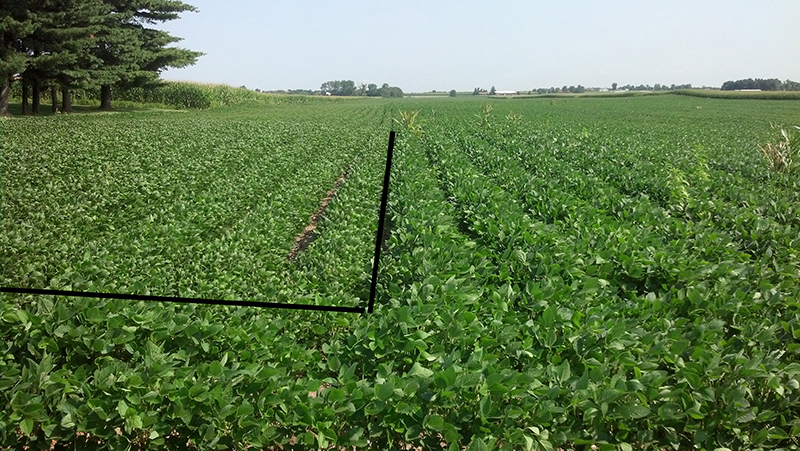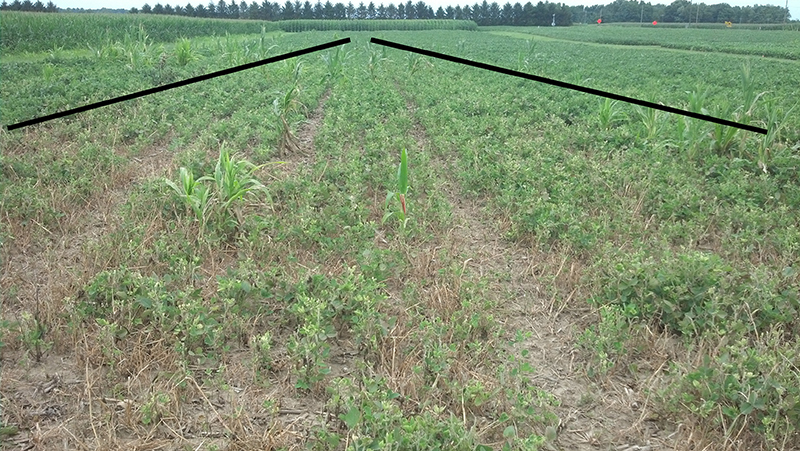Picture of the week
July 31, 2023
Looking for signs in the field
Marcelo Zimmer, Weed Science Program Specialist
Department of Botany and Plant Pathology, Purdue University
Signs are cues that convey some meaning of information. We use them every day whether it’s a stop sign telling us to stop at an intersection or a burnt smell indicating that you left your popcorn in the microwave a little too long. We can also use signs or patterns in the field to help diagnose stresses to the crop. In instances of herbicide contamination in spray equipment there are a couple signs or symptoms that can quickly help conclude that the spray equipment contamination is too blame.
Sprayers make paths of straight lines up and down the field and therefore when a problem occurs the signs of the problem will also show up in these straight-line paths. Naturally occurring stresses such as nutrient deficiencies, insect damage, and plant pathogens do not occur in these neat straight lines. Being able to identify a few of these signs or patterns in the field can go a long way to helping identify the culprit. The two pictures show examples of how these unnatural or mechanical patterns in the field help to diagnose sprayer contamination events.
In the first picture you can see that the soybeans to the left of the black line appear to be stunted and deformed as compared to soybeans to the right. In this particular case the sprayer had made a single pass down the left side of this field to reach another field behind and the operator decided he might as well spray that strip while he was driving down it. A benign decision by the operator turned into a key pattern that helped identify what had injured the soybean plants in the target field that he was traveling to. The injured soybeans were in perfect straight path that the sprayer had traveled, again a naturally occurring stress would not occur in a straight line. In the picture you can also see where the operator turned on the sprayer with differences in soybean height above and below the horizontal black line. Using these patterns in the field as well as symptoms on individual plants it became apparent that a herbicide had contaminated the spray tank and was causing injury to the soybeans.
 Figure 1. A pattern of stunted soybean plants in a straight line down the left side of the pictures indicate that there was a contaminate in the spray tank.
Figure 1. A pattern of stunted soybean plants in a straight line down the left side of the pictures indicate that there was a contaminate in the spray tank. The second picture shows another case where soybeans were injured by a herbicide contaminate in the sprayer. Again signs in the field indicated a mechanical pattern of injured soybeans. In this particular case the lines are not perfectly straight, but the injury could be seen most prominently where the sprayer entered the field with the pattern being the same width of the sprayer boom. This time the injury did not follow a straight-line path where the sprayer traveled, but rather tapered down to a point in the center of the spray boom and lessened in severity as the machine made the pass. This is a case of the contamination actually being contained in the spray boom. The contaminate was at its highest concentration at the beginning of the field and therefore the entire spray swath of soybeans were injured. As the sprayer traveled down the field or away from the camera the contaminate was flushed out of the boom and eventually cleared leaving a tapering pattern of injury as observed in the picture.
 Figure 2. Severe injury to soybeans the entire width of the sprayer where it entered the field with that injury tapering off in width and severity as the sprayer traveled into the field indicate that was a contaminate in the spray boom.
Figure 2. Severe injury to soybeans the entire width of the sprayer where it entered the field with that injury tapering off in width and severity as the sprayer traveled into the field indicate that was a contaminate in the spray boom. 
